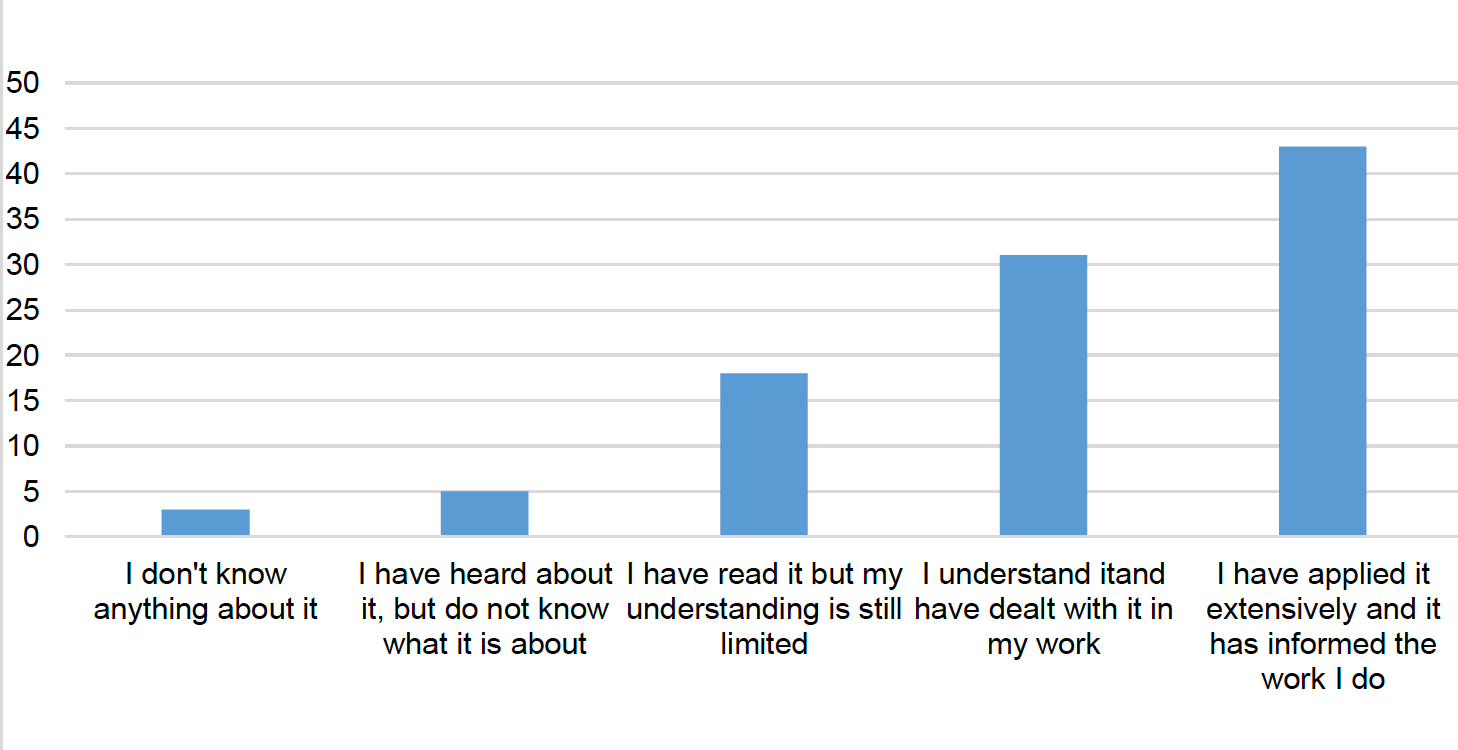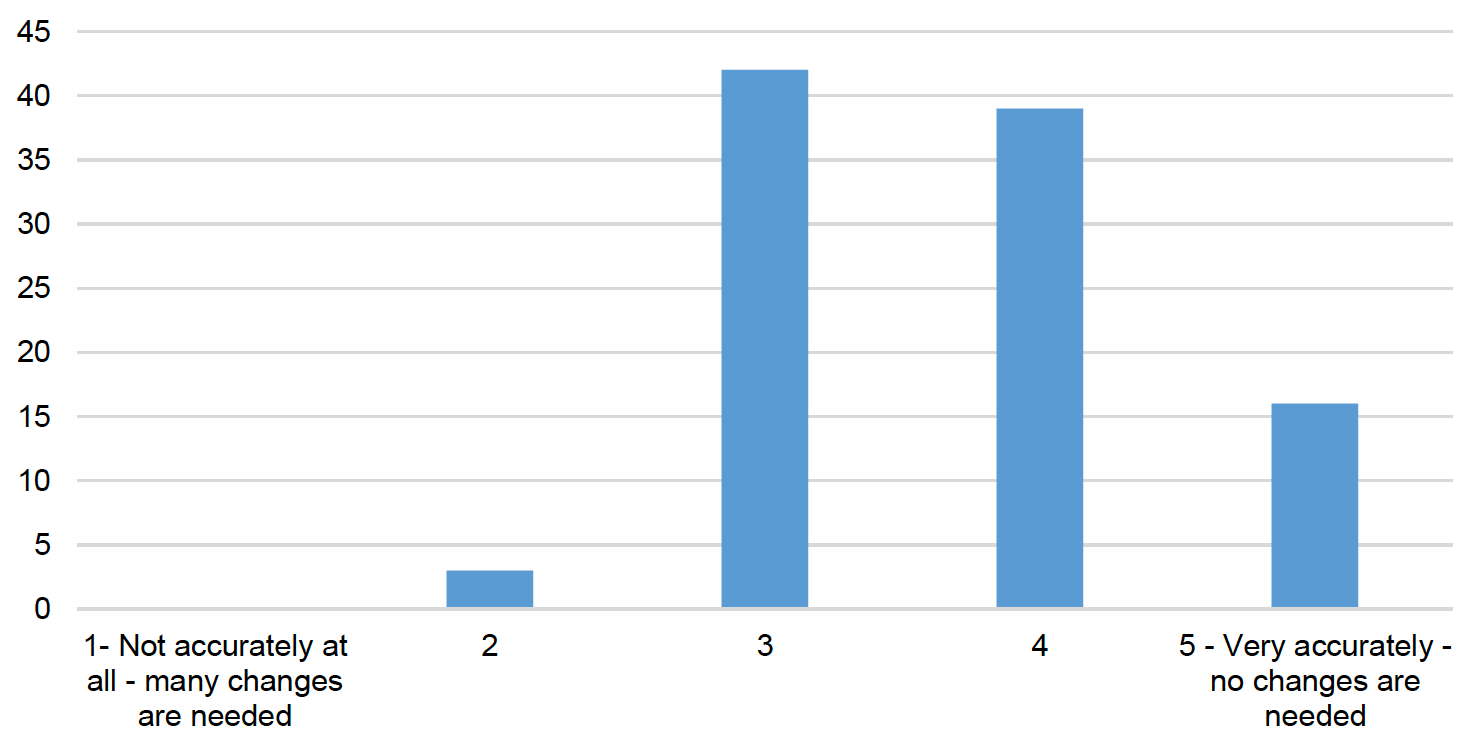Post-2020 global biodiversity framework - Edinburgh Process: report
This report details the outcomes of the Edinburgh Process for subnational and local governments and Edinburgh Declaration relating to the post-2020 biodiversity framework.
Annex 2 : Subnational constituency views on the plan of action on subnational Governments, cities, and other local authorities for Biodiversity (2011-2020)
1. Respondents made their inputs to the Plan of Action (PoA) Review via an online consultation that was open between 29 April and 12 June 2020. The consultation tested the level of understanding and familiarity with the current PoA among respondents, and obtained inputs on a renewed and stepped up PoA.
2. Figure 1 below, shows a strong level of understanding of the PoA among respondents: The majority have either dealt with it in their work or applied it extensively as an informant to their work; 18% indicated a limited understanding but had read the PoA; while only 5% said they had heard about it but did not know what it is about; and 3% knew nothing about it. This affirmed the relevance of the responses received, and indicated that the PoA has been used by subnational and local governments. This is further rationale for the need to renew the Plan of Action through a new, dedicated, stepped-up Decision at COP15.

Recommended elements for a renewed Plan of Action
3. The review document of the current PoA, proposed seven elements for subnational and local government action to be included in a stepped-up decision and renewed PoA. Respondents were asked to rank each element in terms of its relevant importance in informing the work of subnational and local governments in the coming decade (2020-2030). The results of the ranking process are reflected in table 1 below:
| Elements for inclusion in renewed PoA | Av. Ranking (out of 5) |
|---|---|
| The inclusion, as appropriate, of subnational and local government in 2030 and 2050 goals and 2030 action targets; | 4.89 |
| Mainstreaming of biodiversity at subnational and local levels; | 4.85 |
| Resource mobilization for increased investment in biodiversity action at subnational and local levels; | 4.84 |
| Tailoring CEPA initiatives and instruments to the subnational and local contexts (communicating, educating and raising public awareness); and | 4.77 |
| Monitoring, evaluation and feedback by subnational and local governments; | 4.74 |
| Support for networks and alliances to accelerate biodiversity action by subnational and local governments. | 4.71 |
| Capacity-building for subnational and local governments; | 4.69 |
4. Generally, there was a low degree of variance between the rankings, showing that all were seen as being important; and the need for including subnational and local governments in the goals and targets of the post-2020 GBF was seen as critically important. Respondents identified biodiversity mainstreaming as key to achieving the objectives of the post-2020 GBF and indicated that this can only be achieved by strengthening multi-level governance in the coming decade.
5. Concerning resource mobilisation to support subnational and local biodiversity action, respondents pointed to a lack of access to funding mechanisms at subnational and local levels; the need for greater involvement of subnational and local governments in setting targets, monitoring frameworks, and reporting mechanisms; and a need for stronger cooperation between subnational and local governments and for stronger recognition of their critical role in implementing the post-2020 GBF.
6. Respondents were asked to what degree they believed the above-mentioned elements accurately captured the needs of subnational and local governments to fully support Parties in the development and implementation of an effective, inclusive and bold new global biodiversity framework. Using a ranking of 1-5, the majority of respondents felt the recommended elements accurately reflected the constituency's needs but required some changes. The results of the ranking are reflected in figure 2 below:

Reflections on the current Plan of Action
7. Respondents were asked to reflect on the current Plan of Action by ranking the degree to which they perceived that it had achieved its objectives. Their responses are captured in table 2 below:
| Question | Av. Ranking (out of 5) |
|---|---|
| In your view, to what extent has the level of engagement between national and local/subnational governments improved in the last decade in pursuit of the successful implementation of National Biodiversity Strategies and Action Plans, the Strategic Plan for Biodiversity 2011-2020, the Aichi biodiversity targets, and the programme of work under the Convention on Biological Diversity? | 2.97 |
| In your view, to what extent has coordination and the exchange of lessons learned improved over the last decade between Parties, regional and global organisations, United Nations and development agencies, academia, and donors on ways and means to support local and subnational authorities to manage biodiversity sustainably, provide ecosystem services to citizens, and incorporate biodiversity concerns into urban planning and development? | 3.18 |
| In your view, to what extent have policy tools, guidelines, and programmes that facilitate local action and build local capacity to support national governments in implementing the global biodiversity agenda been identified, enhanced, and disseminated to date? | 3.00 |
| In your view, to what extent have local and subnational awareness-raising programmes on biodiversity for local residents, in line with communication, education, and public awareness strategies, been developed over the last decade? | 3.16 |
| In your view, to what extent have global partnerships been leveraged effectively to implement the Plan of Action, in alignment with national and local/subnational priorities? | 3.05 |
| In your view, to what extent has the success of local and subnational action for biodiversity (under the Plan of Action) been measured by appropriate mechanisms, including, for example, assessment tools and/or requirements that national government include information on cooperation between different levels of government, and with relevant local organisations, in its monitoring and reporting processes? | 2.87 |
| In your view, to what extent have national governments supported local and subnational governments with regards to identifying, leveraging, and earmarking funding? | 2.58 |
- Knowledge sharing and peer exchange were seen to have improved among subnational and local governments; and
- Some programmes were highlighted as best practice.
- for greater vertical integration of policies and plans (NBSAPs in particular);
- to strengthen resource access and mobilization, and capacity building for subnational and local governments;
- to improve integration of subnational networks and global platforms, and to develop tools, guidelines, plans, and programmes with the support and participation of subnational and local governments, NGOs and civil society;
- for more inclusivity and flexibility of policies and guidelines at subnational levels;
- for communication, education and public awareness (CEPA) initiatives and programmes to be developed at each level of government, to address language barriers and use non-technical language;
- for a more unified and standardized reporting system at global, national, regional & local levels; and
- for flexible resource mobilisation mechanisms, to allow the decentralisation of re-allocation funds to subnational and local levels.
Contact
There is a problem
Thanks for your feedback